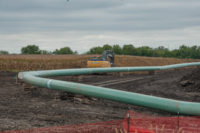With billions in federal funding augmenting construction budgets, infrastructure agencies across New York and New Jersey are fast developing programs to expand transportation, energy and environmental infrastructure and boost resilience and sustainability.
But the surge of projects getting underway could collide with major obstacles in keeping jobs fully staffed, on track and able to surmount key cost risks, regional and state officials told more than 400 attendees at ENR’s second annual NY/NJ Infrastructure Forum held on Sept. 15 in Manhattan.
Kathryn Garcia, director of operations and infrastructure in the office of New York Gov. Kathy Hochul (D), acknowledged the “record support this region has received from our friends in Washington for rebuilding, reimagining and expanding all forms of infrastructure—from wind farms to broadband cable.” She noted it is not “hyperbole to say that the Bipartisan Infrastructure Law and the Inflation Reduction Act are some of the most transformative pieces of legislation ever passed."
Garcia added: "That’s why we have to capitalize on this moment. If we can’t get these projects out the door, in the ground and delivered on time—and please, please, please on budget—this great opportunity will not come again.”
Gov. Hochul has made 21st century infrastructure a priority not only by leveraging federal funding, but by adding $20 billion in capital investment in the most recent state budget for transportation, education, housing and health care, Garcia explained.
“A key to our success will be all of you,” Garcia said. “We know that we need the architects, the engineers, the planners and the contractors."
Her concern is that young engineers want to be computer scientists. "Nobody wants to build a bridge anymore," she said, posing a question: "How do we continue to talk about this industry in a way that we're attracting the next generation, because some of these projects are generational.” Garcia confirmed New York's commitment to move forward on generation-defining projects, in a continued partnership between government, community and business.
Gateway Program Advances
The momentum for the $16.1-billion Gateway Program to add two rail tunnels beneath the Hudson River between New York and New Jersey—and related infrastructure to improve train service in and out of New York City—has accelerated as federal funding has begun to arrive. With the first contracts going out and the larger bidding packages taking shape, the program is finally moving ahead, said James A. Morrison, chief technology officer for the Gateway Development Commission.
The first contracts for the initial tunnel site on the New Jersey side are set to start this year, at a site on Tonnelle Avenue in North Bergen, N.J. As the primary access for tunneling operations and the eventual launch site for tunnel-boring machines, it is considered a key first step for the larger construction effort, Morrison said.
 Image Courtesy Gateway Tunnel Commission
Image Courtesy Gateway Tunnel CommissionThe decision to break up Gateway's project delivery package into separate contracts has allowed for smaller project components to advance while procurement is still being sorted out for more complex tunneling portions, he explained.
“Until about 2021 this was envisioned as one construction project from beginning to end. And it was a large, large package to do that,” said Morrison. “We heard loud and clear [from the industry] that this was too much risk for one entity to take on too, too much diversity of equipment.”
 Map image courtesy Gateway Development Commission
Map image courtesy Gateway Development CommissionBreaking up the bid packages has allowed for different tasks to go to different contractors, separating the tunneling work from the stabilization work, for example. Work on concrete caissons on the New York side at Hudson Yards is expected to begin later this year, while a contract to perform extensive ground stabilization along the New York side of the Hudson River is out for procurement now, and is expected to be awarded in February.
That stabilization work will be one of the most visible signs of construction on the project so far. There will be barges floating in the Hudson, though most of the work will be happening underground.
“What you will see over the next several years is some type of containment cofferdam in the river," said Morrison. "You'll see cranes sticking up but the real work is happening under 50 feet of water.”
New York State Transportation Update
Richard D. Wilder, deputy chief engineer and director of the office of design at the New York State Dept. of Transportation, said the agency is committed to “reconnecting communities, replacing antiquated infrastructure and improving our system” to be more resilient and sustainable.
The DOT's five-year capital plan has a budget of $32.8 billion. DOT is one year into that program. Wilder says they are on time and on budget.
An example of the more resilient approach is that DOT is increasing the design storm by 10% in the west half of the state and 20% in the east half. Regarding sustainability, the 422 replacement culverts will have natural beds. Natural seed mixes will be used to reduce maintenance costs. There are pollinator seed mixes to improve the farming industry and bee population; approaches to control invasive species; and designs to give stream beds the ability to retain water to minimize downstream erosion.
DOT has 1,500 projects under way. A major one to reconnect a community bisected by an Interstate is a $2.25-billion project in Syracuse to reroute I-81 that cuts through downtown and severs the 15th Ward, a historic black community, from the rest of the city. I-81 will become a tree-lined surface business Route 81 and I-81 will be rerouted to the east along the I-481 corridor.
The project has been split into five contracts. DOT is getting ready to advertise the third contract within a couple of weeks. The fourth and fifth contracts will be let early next year.
Another project is the capping of a 1.4-mile sunken stretch of the Kensington Expressway in Buffalo, which bisected neighborhoods. The cap project, which calls for a tree-lined boulevard at grade, is in the design phase. There will be a public hearing later this month, said Wilder.
On the transit side, coming up next year is the tender for the Livingston Avenue Rail Bridge over the Hudson River in the capital district, between Rensselaer and Albany. The century-old swing- span bridge, which opens 400 times a year, doesn’t always close, said Wilder. The replacement will not only improve the reliability of Amtrak service, it will have bike, pedestrian and vehicular lanes that will reconnect communities and parks on both sides of the river.
NYS DOT also is engaged in adding electric-vehicle charging stations to enable trips around the state. The fast-charging stations will be placed every 50 miles along the routes and will be able to accommodate four vehicles at once.
Greater Funding for Climate Resilience
Several speakers at the forum said the infusion of funds has been a game-changer for infrastructure. Robyn Colosimo, a deputy assistant U.S. Army secretary, said Infrastructure Investment and Jobs Act funding has helped chip away at a more than a $100-billion backlog of U.S. Army Corps of Engineers projects. The law provided nearly $479 million for construction of a new facility at the Soo Locks in Michigan, after being unfunded for more than 20 years, she said.
Some officials noted the need to streamline resilience processes and programs within and among agencies to “build capacity” for critical projects to meet the effects of climate change, such as sea-level rise and extreme weather. The New York City Dept. of Design and Construction is pushing to use alternative delivery methods, particularly design-build, on water infrastructure and resilience projects, said Thu-loan Dinh, its assistant commissioner for infrastructure.
 Deputy Assistant Secretary of the Army Robyn Colosimo (second from left) sees new funding as a major opportunity to tackle the Corps of Engineers project backlog.
Deputy Assistant Secretary of the Army Robyn Colosimo (second from left) sees new funding as a major opportunity to tackle the Corps of Engineers project backlog.Photo by Kristen Blush
Currently, the agency can only use a design-bid-build approach. While progressive design-build is not the best delivery method for every project, the ability to be able to identify and use the optimum approach for each project would “be so helpful for the city or the city agencies to make sure we can deliver [projects] … as efficiently and streamlined as possible,” she said.
Michael DeSena, senior engineer at the Passaic Valley Sewerage Commission in Newark, N.J, the state’s largest wastewater utility and one of the largest in the U.S., said Superstorm Sandy devastated the Newark Bay wastewater treatment plant and its connected sewer lines in 2012, sending untreated sewage into nearby waterways. His agency now is overseeing more than $1 billion in resilience-related projects, including construction of a two-mile flood wall to fortify the 300-mgd wastewater treatment plant.
The wall is still not complete more than 10 years after the storm, largely due to supply chain issues. “You need an interim mitigation process while you’re finalizing the [long-term] one,” DeSena said.
In the Army Civil Works program, Colosimo also pointed to the need to focus on the gap between immediate response and long-term projects. “There’s really nobody leading short-term recovery beyond the response, and that’s where the interest starts to wane and drop off,” she said.









Post a comment to this article
Report Abusive Comment